|
|
|
Sort Order |
|
|
|
Items / Page
|
|
|
|
|
|
|
| Srl | Item |
| 1 |
ID:
180176


|
|
|
|
|
| Summary/Abstract |
Can community energy help to overcome inequalities in who benefits from low-carbon technologies? Research has shown that the distribution of low-carbon technology subsidies and their associated benefits can be highly uneven across socioeconomic groups, revealing a persistent inequality issue. Yet this research has tended to focus almost exclusively on adoption of technologies at the household-level, with limited insights into whether and how this distribution might differ in the case of community energy. To address this, this paper quantitatively investigates the distribution of payments to household- and community-level energy systems across socioeconomic groups in Scotland under the UK government feed-in-tariff. Analysis is conducted on a novel dataset of 26,218 household and community wind and solar installations across 6,976 micro-level data-zones using a combination of distributional analysis and random effects within-between regression. It finds that feed-in-tariff payments for household-level wind and solar PV systems have heavily benefitted more affluent socioeconomic groups, while payments to community energy projects have flowed more consistently into areas of higher deprivation, particularly in the case of community solar. These findings suggest that community energy has been successful in bringing the benefits of low-carbon technologies to areas of lower income and higher deprivation, with important lessons for policymakers concerned with a just transition going forward.
|
|
|
|
|
|
|
|
|
|
|
|
|
|
|
|
| 2 |
ID:
175929


|
|
|
|
|
| Summary/Abstract |
As global investments continue in renewable energy technologies, investment costs have declined significantly. Meanwhile, many governments have shifted from pre-set renewable support schemes to auction schemes in order to introduce competition in price setting. Turkey has initiated Renewable Energy Resource Zone (RERZ) auctions to promote solar photovoltaic (PV) and wind technologies. We examine the first of these auctions, Solar PV RERZ, which has ambitious targets in terms of increasing solar PV capacity and enhancing domestic competence in solar technologies. Despite the auction being hailed as a success in terms of low prices, we utilize the Levelized Cost of Electricity generation (LCOE) analysis to demonstrate that the project is vulnerable to macroeconomic shocks and financial risks. Model results show that the capacity factor is the most prominent factor in costs, and 10% change in the capacity factor affects the LCOE about the same rate. Investment cost and interest rate are the other major factors affecting the LCOE. Based on these results, we make recommendations by discussing how Turkey can improve its auction design by incorporating some of the elements used by Brazil and South Africa.
|
|
|
|
|
|
|
|
|
|
|
|
|
|
|
|
| 3 |
ID:
183036
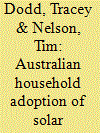

|
|
|
|
|
| Summary/Abstract |
Prior studies establish that electricity systems across the globe need to transition toward renewable energy and that renters have a low adoption of effective means to do so through access to household solar photovoltaics (PV). Yet, the economic, environmental, and social costs of low PV adoption by people who have trouble paying their electricity bills (hardship customers), who are more likely to be low-income tenants, remain understudied. Drawing on electricity use data from an Australian energy retailer we compare the performance of PV for hardship customers against ‘average’ households. Results illustrate that if society could achieve greater solar PV installation on hardship homes, annual grid-based electricity consumption could be reduced by 40%, lowering greenhouse gas emissions by 1.6 tCO2e per household annually and energy bills by $2908 per low-income household over 15 years. We illustrate how Australian policy could be re-oriented to encourage greater PV adoption on hardship properties, including through support for a new market structure that distributes the economic benefits of PV between renters and landlords.
|
|
|
|
|
|
|
|
|
|
|
|
|
|
|
|
| 4 |
ID:
150703


|
|
|
|
|
| Summary/Abstract |
Diverse solar PV business models and financing options exist in the international landscape, helping expand and accelerate the adoption of rooftop solar PV systems. The conditions for their emergence are context specific, depending on the policies, regulations, incentives, and market conditions of each country. After a review of the international landscape, this paper compiles and analyzes business models and financing options for rooftop solar PV investment in Thailand that have emerged during the period between 2013 and 2015. Despite policy discontinuity for the support of rooftop solar systems, diverse business models and financing options are driving market expansion and expanding solar access to more Thai consumers. Drawing on our policy and regulatory analyses and in-depth interviews with business representatives, we identify four types of business models and one financing option. The business models include Roof Rental, Solar PPA, Solar Leasing, and Community Solar, and the financing option is the solar loan. We analyze the drivers for their emergence, barriers to their success, and the risks from the business owners' and consumers' viewpoints. Our policy recommendation is focused on crafting a net-metering regulation with evidence-based studies on the potential costs and benefits to different stakeholders.
|
|
|
|
|
|
|
|
|
|
|
|
|
|
|
|
| 5 |
ID:
183563


|
|
|
|
|
| Summary/Abstract |
Financial incentives, such as rebate programs, are widely used to promote the adoption of residential solar photovoltaic systems. This paper studies the changing effectiveness of rebate programs as the solar market evolves. We develop a theoretical model to first characterize individual treatment effects then aggregate them to regional effect, and hypothesize that the aggregate treatment effect of rebates first increases and then decreases with declining costs and increasing net metering rate. We empirically test our hypotheses by estimating the treatment effect of rebate rate in California from 2006 to 2017 and its interaction terms with installation cost and residential electricity rate. Results confirm our hypotheses and identify an installation cost of $8.84/W and a residential electricity rate of 22.36c/kWh as the turning points where rebate impacts start to decline. Our findings suggest that front-loaded rebate rate design can be an effective and efficient tool at promoting residential solar adoption.
|
|
|
|
|
|
|
|
|
|
|
|
|
|
|
|
| 6 |
ID:
192826
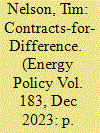

|
|
|
|
|
| Summary/Abstract |
This research advances knowledge regarding social equity as it relates to electricity network charges, renewable investments, and household income. While much research has examined social equity issues related to electricity access, research has yet to fully explore how different network tariff designs used to recover the cost of renewable energy investments, such as those related to ‘Contracts-for-Difference’ (CfDs), impact low-income individuals. We accordingly examine CfDs in more detail, assessing if regressive effects emerge from levying CfD cost recovery via network charges. By analysing energy use and network design charges in Australia, we find that CfDs are a regressive form of taxation used by state governments to fund renewable energy commitments. We illustrate the impact that CfDs have on different energy users and provide recommendations to reform renewable energy policies to provide greater social equity.
|
|
|
|
|
|
|
|
|
|
|
|
|
|
|
|
| 7 |
ID:
168695


|
|
|
|
|
| Summary/Abstract |
With rapid economic growth in the past four decades, China has grown into the world's largest fossil fuel consumer and CO2 emitter. Surprisingly from a negligible level in early 2000s, the country has also become a global leader in solar PV utilization. In the past two decades of renewable energy development, wind power dominated before 2012, while annual solar PV installation quickly caught up afterwards. This article explains the solar PV trajectory as China followed the comparative advantage of wind power and solar PV, contingent upon their relative costs, for achieving renewable energy goals. We further explore why China with a tradition of central planning could approach the least-cost, market-oriented roadmap. Several factors were effective in enabling the “comparative advantage strategy” without central planning but mainly bottom-up decision making, including cost-conscious state-owned electric grid corporations, policy and goal evolution by implementation selection, and constrained solar lobby. This strategy could provide helpful insights for China and other countries for achieving their renewable energy development and CO2 mitigation commitments as well as other major policy goals.
|
|
|
|
|
|
|
|
|
|
|
|
|
|
|
|
| 8 |
ID:
128452


|
|
|
|
|
| Publication |
2014.
|
| Summary/Abstract |
The last twenty years have seen the growth of both solar PV manufacturing capacity and deployment in China, yet this growth has followed a very erratic path. This study applies the concept of socio-technical regime to identify factors which have made this path so erratic. We examine four stages in China's solar PV policy from mid-1990s to 2013 and show that each is characterized by different combinations of policy program. These changes in government policy and in the resultant trajectory of the solar PV sector are attributed to three main sets of variables. The most important of these are events which shape the wider policy priorities of China's government. Secondary factors include the government's poor management of the policy interaction between the domestic solar PV manufacturing industry and the deployment of solar PV across the country, as well as policy learning within government. The general lesson from this study is that the development path of a single element of a national strategy for the low-carbon transition is likely to be erratic, subject as it is to a range of political and economic forces, and to experimentation and learning.
|
|
|
|
|
|
|
|
|
|
|
|
|
|
|
|
| 9 |
ID:
180127


|
|
|
|
|
| Summary/Abstract |
The global energy transition may have unintended consequences for businesses that provide services to the coal sector. Businesses operating in coal regions like Steve Tshwete Local Municipality (STLM) might be left stranded due to the coal phase-out. However, solar photovoltaic (PV) business opportunities can support a just energy transition. The diffusion of solar PV owing to the available grid infrastructure and solar energy resource (5.61 kW/m2/day) in STLM, South Africa positions this region as a potential solar development area. Therefore, leveraging solar PV commercial benefits for local enterprises is just. This study deployed a structured survey to understand solar business involvement and opportunities in STLM. The study found that 57.1% of businesses operating in STLM offer services to either coal mines or coal power stations. Only 14.3% of businesses were found to have offered services in the solar PV sector, signalling low participation. However, this does not mean that STLM businesses cannot increase their participation in the solar PV sector thus mitigate against potential coal phase-out socio-economic impacts. The exploratory factor analysis deployed for data analysis showed two factors (solar opportunities and regional participation) that were found to be reliable and valid on the Cronbach's Alpha test.
|
|
|
|
|
|
|
|
|
|
|
|
|
|
|
|
| 10 |
ID:
183611


|
|
|
|
|
| Summary/Abstract |
What drives inequalities in the uptake of low-carbon energy technologies? Research has shown that people on higher incomes are significantly more likely to access and benefit from policies designed to boost uptake of clean energy technologies than those with lower incomes, revealing a pervasive inequality issue. Yet little is known about how these inequalities evolve or interact with factors beyond income alone, understanding of which is crucial to designing policies which do not simply replicate or exacerbate existing inequalities going forward. This paper thus advances the novel “feed-in-tariff trap” theory, which posits that, rather than income alone, peer diffusion and socioeconomic factors compound to widen inequalities in the uptake of low-carbon technologies over time. Using a combination of mixed effects and piecewise structural equation modelling, this theory is tested on the adoption of 21,206 household-level wind and solar PV installations across 6976 micro-level data-zones in Scotland between 2009 and 2020 under the UK government feed-in-tariff. It finds crucially that: (1) household solar PV and wind are adopted consistently in higher-income areas, (2) peer diffusion is strongest in higher income areas with high early adoption rates, and (3) socioeconomic conditions are extremely temporally stubborn. Combined, this trifecta creates an inequality “trap”, locking the benefits of low-carbon technology subsidies into the same higher income areas and widening the gap in uptake between more affluent and deprived communities as a result. Recommendations are given on how best to address this, with implications for anyone concerned with a “just” transition going forward.
|
|
|
|
|
|
|
|
|
|
|
|
|
|
|
|
| 11 |
ID:
166313
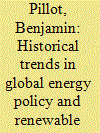

|
|
|
|
|
| Summary/Abstract |
From 1972 and the Meadows report to 1997 and the ratification of the Kyoto Protocol by most of the countries in the world, the global energy policy framework has moved on to considering the concept of sustainable development. Regarding electrification, modern renewable power systems such as solar PV have sprung up in the wake of this major mutation and have typically undergone a significant growth since the beginning of this century. In this paper, we first investigate the historical interactions between energy and society in both global and Sub-Saharan contexts and how renewable power has ended up being considered accordingly. From the need for sustainable development to grid-connected architecture on the one hand; from the lack of human development to rural off-grid electrification on the other. Then, using the case of solar PV, we propose a reading of the issues and challenges renewable power systems are currently facing in Sub-Saharan Africa, by linking those aspects to the previously stated global policy framework, and in particular the historical segmentation of the renewable energy worldwide market between grid-connected and off-grid sectors.
|
|
|
|
|
|
|
|
|
|
|
|
|
|
|
|
| 12 |
ID:
176812


|
|
|
|
|
| Summary/Abstract |
Information campaigns promoting sustainable technology adoption are common. However, knowledge about their effects is limited. In this study, the effect of a Swedish information campaign for solar photovoltaics (PV) adoption is evaluated quantitatively. The campaign took place in Sweden in 2017 and was directed towards homeowners. 41% of all Swedish municipalities participated, creating a ‘treatment’ and a ‘control’ group. As dependent variables, we used applications and approvals for a nation-wide PV subsidy scheme. Few Swedish PV installations have historically occurred outside of the subsidy scheme, which is quite accessible and offers a substantial rebate. Thus, the data were assumed to correspond well with actual installations. Hierarchical linear regression, with a set of control variables, was used. We found that campaign participation was associated with a 29% increase in submitted and approved subsidy applications. Thus, we conclude that the information campaign had a significantly positive effect on PV adoption rates, and that policy makers in other countries with limited PV penetration could launch similar campaigns to elevate PV adoption rates.
|
|
|
|
|
|
|
|
|
|
|
|
|
|
|
|
| 13 |
ID:
150773


|
|
|
|
|
| Summary/Abstract |
Installations of rooftop solar photovoltaic (PV) technology in the United States have increased dramatically in recent years, in large part because of state and federal subsidies. In the future, such subsidies may be reduced or eliminated. From the homeowner's perspective, solar PV is competitive when it can produce electricity at a cost equivalent to the retail electricity rate, a condition sometimes referred to as “socket parity”. In assessing the economic viability of residential solar PV, most existing literature considers only a few locations and fails to consider the differences in PV system cost and electricity prices that exist across the U.S. We combined insolation data from more than 1000 locations, installation costs by region, and county-level utility rates to provide a more complete economic assessment of rooftop solar PV across the U.S. We calculated the break-even electricity prices and evaluated the reductions in installed costs needed to reach socket parity. Among the scenarios considered, we estimate that only Hawaii has achieved socket parity without the use of subsidies. With subsidies, six states reach socket parity, yet widespread parity is still not achieved. We find that high installation costs and financing rates are two of the largest barriers to socket parity.
|
|
|
|
|
|
|
|
|
|
|
|
|
|
|
|
| 14 |
ID:
177444


|
|
|
|
|
| Summary/Abstract |
The Chinese government has established a photovoltaics poverty alleviation (PVPA) program to help reduce rural poverty and environmental inequality. However, there is a scarcity of detailed investigations into how social-psychological factors influence the rural poor's decision to adopt solar photovoltaics. The present study examines the local voices of low-income villagers in the Wuhan region towards the PVPA projects from a social-psychological perspective. While focusing on local villagers' opinions before the onset of the COVID-19 pandemic, our findings suggest that villagers' neighbors have the greatest influence on those who subequently adopt solar PV. Similarly, village agents play a crucial role in spreading information and creating a sense of trust, which is different than other countries' solar adoption. The common goals of improving the local community aesthetically, environmentally, and economically also increased villagers' adoption likelihood. These improvements boosted villagers' sense of pride, which, in a virtuous cycle, further encouraged participation in improving the community. Residents' fears were reduced through local social interactions which increased knowledge, such as village-wide technology demonstrations, conversations with local adopters, and town hall discussions with village leaders. However, --- the PVPA projects and skepticism about when or if they would receive promised government subsidies prevented many from adopting. These findings provide valuable implications for policymakers in China and other developing countries who wish to encourage renewable energy adoption after the pandemic.
|
|
|
|
|
|
|
|
|
|
|
|
|
|
|
|
| 15 |
ID:
166410


|
|
|
|
|
| Summary/Abstract |
Market demand is an important driver for inducing innovation, with many empirical studies supporting the demand-induced innovation hypothesis. Critiques of such studies, however, emphasize that new empirical evidence that can address existing empirical challenges is needed. Furthermore, existing literature disagrees about whether the locus of demand-pull policy matters. In this paper, we use empirical evidence from the distributed solar photovoltaic (PV) market in China to address the following questions: (1) Is there evidence of demand-induced innovation? (2) Does the effect of local demand-pull policy differ from the effect of non-local demand-pull policy on demand-induced innovation? To address these questions, we develop and analyze an original database of PV balance-of-system (BOS) patents in the distributed PV market filed between 2005 and 2014 in China. Our results support the demand-induced innovation hypothesis and suggest that only local demand significantly induces PV BOS innovations in the distributed PV market in China. The different effects of local demand and non-local demand emphasize the importance of local markets and local policies, lending some support to bottom-up approaches to clean energy governance.
|
|
|
|
|
|
|
|
|
|
|
|
|
|
|
|
| 16 |
ID:
188572


|
|
|
|
|
| Summary/Abstract |
In this paper, the questions of how support policies affect invention and diffusion of solar PV technology and whether the effect is heterogeneous and counteracting are investigated in order to help policy makers produce a better policy mix. The policies (and policy proxies) investigated are Feed-in-tariffs (FITs), Public R&D stock and flow, Environmental tax, and Environmental Policy Stringency Index. The policies are within the control of national government and no EU level policies are investigated. Evaluating policies on several dimensions is highly important since there is a risk that policies can promote one aspect of technological progress such as invention but derail diffusion. A Schumpeterian technological development approach is utilised on a panel dataset covering 23 European countries between 2000 and 2019. Two econometric approaches are employed, a negative binomial regression model is used to assess inventions and a panel data fixed effect regression is used for the diffusion model. The empirical findings suggest that no counteracting policy effects were present.
|
|
|
|
|
|
|
|
|
|
|
|
|
|
|
|
| 17 |
ID:
105741


|
|
|
|
|
| Publication |
2011.
|
| Summary/Abstract |
The Australian Government ran a renewable energy program in the 2000s that provided rebates to householders who acquired solar Photovoltaic (PV) energy systems. Originally called the Photovoltaic Rebate Program (PVRP), it was rebranded the Solar Homes and Communities Plan (SHCP) in November 2007. This paper evaluates both the PVRP and SHCP using measures of cost-effectiveness and fairness. It finds that the program was a major driver of a more than six-fold increase in PV generation capacity in the 2000s, albeit off a low base. In 2010, solar PV's share of the Australian electricity market was still only 0.1%. The program was also environmentally ineffective and costly, reducing emissions by 0.09 MtCO2-e/yr over the life of the rebated PV systems at an average cost of between AU$238 and AU$282/tCO2-e. In addition, the data suggest there were equity issues associated with the program, with 66% of all successful applicants residing in postal areas that were rated as medium-high or high on a Socio-economic Status (SES) scale.
|
|
|
|
|
|
|
|
|
|
|
|
|
|
|
|
| 18 |
ID:
192712


|
|
|
|
|
| Summary/Abstract |
We develop a concept to identify and quantitatively assess technology selection bias in multi-technology renewable energy auctions. We show that simple price rules are insufficient to efficiently select winning projects in multi-technology tenders when they incorporate individual costs of producers only, and exclude system effects, market benefits and external costs. With our concept of quantifying unit social value, all relevant external elements can be incorporated in the evaluation. The introduction of an objective measure (as difference of differences between unit social value and auction bid prices) allows the quantitative assessment of systematic selection bias between technologies under different remuneration designs. We illustrate our concept by applying it to generic European renewable energy technologies (wind and solar energy) and major applied remuneration types (contract-for-difference and fixed premium schemes). We also show that are concept is applicable for real auction data, by presenting a case study about Italy. The main conclusion of the study is that selection by price only, can constitute a systematic bias for all investigated remuneration designs. Both schemes are in our case biased toward a given technology. The internalisation of external cost may not necessarily lead to better social outcomes in the selection of auction winners, as it can be overshadowed by the initial bias of the chosen remuneration design. We conclude that considerate design, including the potential differentiation of rules, e.g., through introduction of a technology bonus, to minimise selection bias, and careful monitoring of the competitive situation between participating technologies in a multi-technology auction are required to ensure efficient selection.
|
|
|
|
|
|
|
|
|
|
|
|
|
|
|
|
| 19 |
ID:
191251
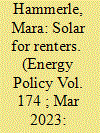

|
|
|
|
|
| Summary/Abstract |
Rooftop solar photovoltaic (PV) systems present households with a way to reduce their energy bills, while contributing to a clean energy transition. However, rental properties are considerably less likely to have solar PV. It is unclear whether current policies that focus on reducing upfront costs to installing solar PV address the barriers perceived as most important by property investors. Using a best-worst scaling survey of 931 property investors, we find that investors on average view renters being unwilling to pay higher rents for properties with solar PV equally as important as affordability concerns as barriers to investment. Owners of apartments or townhouses focus on structural barriers. Our discrete choice experiment of 147 property investors shows that policies that spread solar system payments over time and direct feed-in tariff revenue to property investors are not preferred by most owners of fully-detached rental dwellings. We conclude by stressing the importance of policies that reduce information asymmetries from the property investor perspective regarding the value that renters place on PV systems. There is also a need for policies to better address barriers faced by owners of apartments and townhouses.
|
|
|
|
|
|
|
|
|
|
|
|
|
|
|
|
| 20 |
ID:
166991
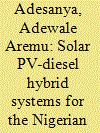

|
|
|
|
|
| Summary/Abstract |
This research examines the impact of Nigerian private sector investment in captive power generation from solar photovoltaic (PV) and diesel generator (DG) hybrid energy systems. The study assesses the economic viability of solar PV-DG hybrid systems among Nigerian private companies using levelized cost of energy (LCOE) and analyzes policies that can facilitate solar PV investment as a bottom-up approach to Nigeria's energy development. Forty (40) private companies across Nigeria were surveyed to examine potential the fuel savings that hybrid of PV and DG can achieve. Out of the surveyed companies, three cases representing different load factors were selected and modelled in HOMER Pro to obtain LCOE for each case study. The research findings indicate that electricity generation deficiencies for Nigerian business consumers can be addressed with available renewable energy solar resources. A savings between € 0.002 and 0.009/kWh was achieved from the three-case study. Adequate policy to support investment is both necessary and possible for achieving increased solar PV adoption for highly willing Nigerian private sector.
|
|
|
|
|
|
|
|
|
|
|
|
|
|
|
|
|
|
|
|
|